#egg incubator temperature
Explore tagged Tumblr posts
Text
A baby rattle snake following its mommy ❤️
Definitions of parental behavior differ, but Shine points out that mother snakes seem to go to some trouble for their offspring. For instance, python moms will often stay coiled around their pile of eggs for about 2 months, even though they haven’t had anything to eat for 6 or 7 months. At first glance, it might seem hopeless for a cold-blooded animal to try to incubate its eggs. When the temperature drops sufficiently, though, the python shivers, thereby warming the clutch with heat derived from muscle activity. Many rattlesnakes and their pit viper cousins don’t lay eggs but instead give birth to ready-to-wriggle offspring. Back in the Chiricahua foothills of Arizona, the black-tailed rattler mother that so excited Hardy and Greene stayed near her youngsters and the sheltering rocks of the birth site for more than 9 days. The scenes that the researchers described in 2002 might apply as well to a mother dog and her pups. On day 4 after the birth, Hardy observed superfemale 21 near the birth site as five of her newborns crawled around. They had worked their way out of the shelter’s entrance, over the mother’s body, and a little way into the surrounding grass. An hour later, several youngsters had piled on top of her. When one wriggled over her head, she tolerantly rearranged her coils. Thus, the days went by with the family basking just outside its rocky den. About 9 days after birth, the little snakes shed their skins as their mother watched from a few inches away. The youngsters then disappeared, presumably crawling off on their own. Greene and Hardy’s detailed monitoring of black-tailed rattler life had convinced them that the females typically don’t eat during winter hibernation or the spring pregnancies that follow. Greene paints a heroic picture of the mother, who further delays her return to hunting. “She hasn’t eaten for about 10 months, but she stays around for 10 more days,” he says. He and Hardy have since observed similar behavior in several females.
Source: https://www.sciencenews.org/article/social-lives-snakes
8K notes
·
View notes
Text
Where Do Red Eared Sliders Lay Eggs?
Red-eared sliders lay their eggs in shallow nests that they create on land. The female will select a site with soft soil and good drainages such as sandy soils or loose leaf litter. She will then dig the nest which is typically 5 to 8 inches deep and 4 to 6 inches wide. Once the nest is complete she will lay between 3-20 eggs depending on her age and health. After laying her eggs she will cover…

View On WordPress
#can red eared sliders lay eggs in water#do red-eared sliders lay eggs without male#how to tell if red eared slider eggs are fertile#red eared slider nesting box#red-eared slider egg incubation temperature#red-eared slider eggs#red-eared slider eggs hatching time#what do red-eared slider eggs look like#Where Do Red Eared Sliders Lay Eggs
0 notes
Text
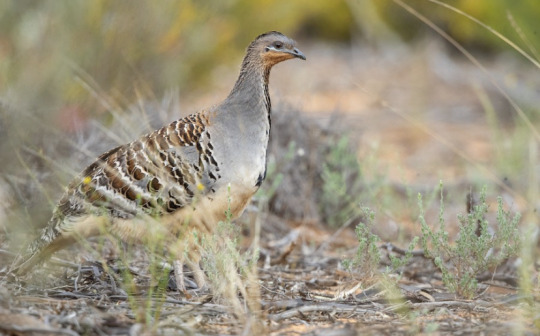
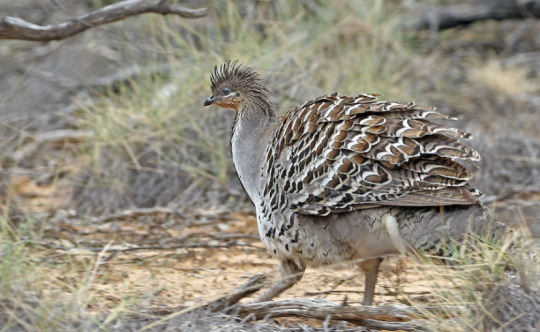
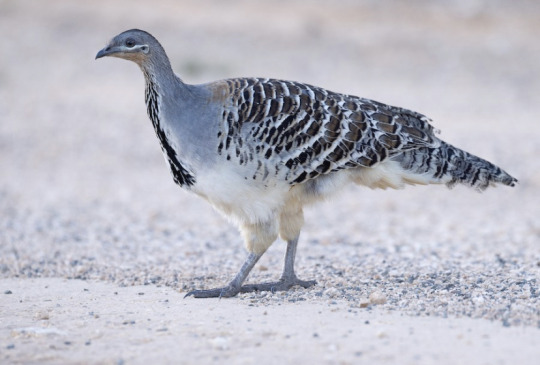
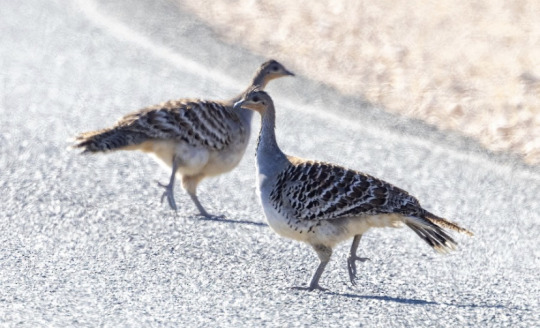
the malleefowl is an intricately patterned ground-dwelling bird approximately the size of a domestic chicken (both birds are in the order galliformes). this bird is native to australia, and though it is active during the day, it is rarely seen due to its complex camouflage, tendency to freeze when spotted, and small range (which has been reduced by habitat loss). these birds are incredibly solitary and, while pairs often mate for life, they rarely interact outside of mating or territory disputes. malleefowl are mound-nesting birds that build an above ground mound (approximately two feet tall) to incubate their eggs in; the internal temperature is regulated by adding sand or soil. chicks hatch one by one, rarely on the same day (incubation can have a wide range of 50-100 days), and are fully independent from the day they hatch.
#Malleefowl#Australia#bird#birblr#galliformes#love ground nesters <3#also today is todaysbirds driving test 😬
2K notes
·
View notes
Note
Monster!Konig with a little cute kitty! She just wants to make him happy but she's to dumb to realize what he needs!!
Awwwww! Konig would definitely humiliate the shit out of his pretty little kitty mate. You're a monster, but you're even weaker than an average human! So adorable and pathetic, Konig just can't wait to claim you as his. Your body is a good enough temperature for his eggs, and your womb could carry so much of his litter...maybe even produce some weird octopus kittens that can be used as universal soldiers! You need to consume flesh as a monster, so Konig would only feed you the tiniest chunks of meat, making you plead and beg each time you're hungry and can barely move from how weak you are...he'd allow you to chew on his tentacles, your sharp teeth are so cute when you think you can really do damage with them...he loves to be covered in your bite marks, it's the testament of how much you adore him - even if you shake and cry every time he touches you a bit too roughly. You're always so dumb and disoriented he has to put you in a tight collar with little chumming bells because it's the only way for you to not get lost! Everyone can hear the little dingle and know that Konig mate is somewhere around here - it's especially useful when dumb ol' you got into a tight space or a really narrow closet because you went into heat and needed a confined space. He would put you in the finest fabrics for your nest, lots of toys and ways for you to play - as long as you're not really trying to escape the fate of being his dumb kitty incubator. You're too weak to survive without him anyway.
1K notes
·
View notes
Text
imagine if a girl laid eggs in you and your body physically responded by becoming the perfect incubator. you put fat on super easily to keep temperature up and cushion the eggs better, brain functions slow down to the point where you can barely be considered awake (stress could damage the eggs), your physiology changes to be able to subsist on a diet of primarily her cum, basically a type of hibernation that's semi-permanent. once the eggs are done incubating you don't change back either, not completely, and your mind has been in such a perpetual cum-drunk haze for so many months that all you can think about is getting more eggs inside you asap at any cost
907 notes
·
View notes
Note
I was reading through animals facts and found something interesting...
"Octopus lay up between 20,000 to 80,000 eggs at a time"
Σ(°ロ°) Azul!?
I mean, I doubt merfolk would lay that many (since Azul is an only child), but imagine if they did lay even close to that amount.
Like Azul deciding to babytrap Darling, and she's expecting one maybe two babies. Only to pop out like 10 tiny little babies. The shock and horror.
Or a scenerio involving alien or eldritch monster Azul, who wants darling to help him repopulate his species. Unaware that he's gonna knock her up with hundreds of babies at a time due to his biology.
I hope this isn't too weird. This fact just got my breeding kink going for some reason.
>:) back on the egg agenda with tako!!!!
I like to imagine mers can produce a lot of eggs (maybe not nearly as much as 20k and maybe some more than other species) but enough knowing that many of those eggs won't survive. Very few fry return from hatching if it's the open ocean,,, although maybe if he keeps you in captivity and you lay the eggs in a safe space where he can watch over both you and the young.... perhaps more will survive. <3
Alien Azul....... waaaa captured and forced to be the broodmother for such a large clutch. orz so heavily knocked up you can't even escape. Not that you ever could before. Maybe he's the creature who invaded your ship and killed all of your fellow crew members,, something something his home planet is no longer habitable, so he's been searching for a place that will be safe to repopulate and live,, or he was the thing kept locked up in a lab and you just happened to be the unfortunate scientist or janitor or security guard who caught his attention. World is cold and cruel, but human womb is warm and soft and perfect temperature for holding and incubating young. >w< if you're so scared, he supposes he can take on a human form, though he's not sure why that would be of any comfort when humans are so fragile and weak and easy to snap in half. :3c his true form is much better suited to protecting you and the babies.
And with so many tentacles at his disposal he can multitask!! Pleasuring you while cleaning up around the little nest/nook he keeps you in,,, feeding you delicious foods he managed to find and gather while filling you up with more slick to keep the eggs properly comfortable inside you. Restraining your arms and spreading your legs if you try to close them or resist in any way. Stuffing one down your throat to keep you docile and quiet whenever you protest. The babies don't need to hear their mother being a brat and pitching a fit. Tsk tsk. Wiping your tears away when you get so overstimulated from all of the attention and appendages stuffed in your holes.
You may think he's inherently cruel, but he's really a gentle creature at heart(s). :( he just wants to start a family and keep his species extant and maybe you'll come to love and appreciate him one day... he likes you a lot,,, if he didn't, he would've torn you apart by now and the walls would've been spattered with blood and gore. He's trying to make this as easy and painless as possible for you, feeding you aphrodisiac fluid so the process isn't uncomfortable, and he's even going out of his way to prepare you! He just wants his mate to be happy and relaxed. >_<
Maybe your mind just can't keep up with all of this,, the body horror and the actual tentacled horror fawning over you. The absurd amount of eggs crammed in your womb and all of these new sensations you've never felt before. Emotions and hormones are all over the place. You can't believe you actually panicked when you woke up one morning and saw he wasn't curled at your side. You actually want him to touch you, to wrap you up and hold you close, to speak to you in his native tongue and then translate in your language in the best way he can... orz you must be losing your mind to find comfort in the very creature who has made you feel so uncomfortable.
#twisted chit chat#n/sfw#tw: oviposition#tw: breeding#tw: pregnancy#tw: dubcon#tw: noncon#nothing is ever too weird dearest anon :D we are all freaks on the merakiui blog <3#ALSO I PROMISE I AM FINALLY BACK ON TAKO AGENDA FOR REALSIES THIS TIME#i saw the glomas tako figure and suddenly my thighs were shedding copious tears (⸝⸝ᵕᴗᵕ⸝⸝)
194 notes
·
View notes
Text
I see people getting confused about what "male" and "female" means for non-human animals (and plants), because it is not at all the same thing as the way it's used for humans, because there are too many variations across many different animals. (I won't even touch on how weird it is for plants.) So to break this down:
Sex: The gametes an animal produces (female for the big gametes, or ova; male for the small gametes, or sperm; monoecious/hermaphrodite for both; asexual for neither). When referring to non-human animals, literally the only thing this means.
Gonads: The organs that make the gametes (ovaries for ova, testes for sperm). Sponges can make gametes without gonads, so gonads are not required for having a sex.
Genitals: A dizzying array of parts that can be used to transfer gametes between individuals. Some males have claspers for opening. Spiders have "penises" in their "hands." Female bark lice have siphons for sucking the sperm out of males. And the vast, vast majority of animals have no genitals at all, because they live in the ocean and just spray their gametes into the open water. Because this varies so much and can even be lacking entirely, it is also not the same thing as sex.
Genotype: What's genetically encoded in an animal. In some, like humans, there's an XX/XY chromosomal system to determine whether an organism makes sperm or ova. In birds, it's ZZ/ZW (that is, two of the same chromosome for males). In wasps, ants and bees, it's haplodiploid, where males have only one set of all chromosomes (the females, like almost all other animals, have two). In some animals, it's not related to genes at all--in crocodilians, sex is determined by the temperature the eggs are incubated at! So, genotype is not the same thing as sex.
Phenotype: The physical expression of an organism--the body. Up to you whether you're including gonads and genitals with that. This can vary depending on sex, to make it more likely animals producing different gametes will be able to identify each other. In some animals, there is absolutely no difference in phenotype between sexes at all. So, this is also not the same thing as sex.
Sex-Linked Behavior: Again, not even present in a lot of animals--or if it is, usually limited only to courtship and mating, because most animals aren't social. Also not the same thing as sex.
Gender: A complicated system that varies dramatically across cultures and is specific to human beings, and tied very closely to human language. Some cultures have only two genders. Some have three, four, or more. What an individual thinks of gender can vary irrespective of culture. It ties in with all the previous things in so many overlapping, intricately linked ways I could not go into them here. This can also be considered "sex," but not at all in the sense that we use it to refer to animals. Likewise, animals cannot be considered to have gender, because they lack the specific human language and culture that gender arises from.
Tl;dr: Please stop using "sex" the same way for both humans and animals. The human definition makes no sense for non-human animals because they get so weird, and it's just plain rude to refer to humans in the animal sense.
2K notes
·
View notes
Text
CW: yandere, (implied) forced breeding in the past, breastfeeding
After these: participate in the ceremony, his attitude towards dragon eggs
Imbibitor Lunae has prepared a warm "nest" for you, with a water bed, thick blankets, and controlled the humidity and temperature of the nest as much as possible. There are now… 5 dragon eggs. Now what you need to do is to take care of these dragon eggs hatching (does he really consider you as a breeding volunteer… think of him saying "stay here forever to take care of the dragon cubs", you put your face in your hands and sob.) Keep Warm them, flip the eggs occasionally, give them nicknames and tag them.
Imbibitor Lunae often checks on you and the dragon eggs, stroking their shells with his fingertips. Hearing their nicknames, his serious expression softened, and he even smiled. After half a month of incubation, the dragon cubs broke out of the eggs one after another. They have inherited his pearl blue dragon horns and tail. You are taken aback by the tail. He explained that the older Vidyadhara knew how to hide the tail, which was also a sign of strength. Baby dragons all snuggle up in your arms to keep warm, wagging their tails and sucking on your breast milk.
#yandere dan heng x female reader#yandere dan heng x reader#yandere honkai star rail#yandere hsr x reader#honkai star rail x reader#honkai star rail x you
2K notes
·
View notes
Text
IceWing tribe sheet!

icewings actually happen to be my favorite tribe, they're a little messed up but i love them. enjoy my headcanons!
Physical Appearance + Traits:
-IceWings live in the cold and barren arctic north, and have developed very specific adaptations in order to survive. Rather than being warm-blooded and keeping themselves insulated, they kept their reptillian cold blood and slowly adapted to a consistently cold internal body temperature. As a result, they require no warmth at all for their bodies to function; they do not insulate themselves with fur or fat like mammals do.
-Their scales are pale, usually with a bluish tint although other colors are not unheard of. When well taken care of, they gleam and sparkle like ice.
-They are naturally cold to the touch, giving off a chill to anyone close by. In warm environments, especially humid ones, the cold will sometimes cause moisture from the air to condense on their scales, letting drops of water settle on them and drip from them. This, at first glance, can sometimes look like they’re “melting”, and has made some believe that IceWings are literally made from ice, and they can melt in the heat. (This is another headcanon that didn’t originate with me, it comes from @flamebringer0. If you see this, I adore your headcanon, I hope you don’t mind me including it among with mine!)
-Sharp spikes bristle their necks and run along their spines and tails. This can make it difficult for other tribes to gain the upper hand in fights without being wounded by the spines. They can also use their tail as an effective weapon.
-They can summon a storm of tiny shards and crystals from the ice that tends to coat their throat and produce frostbreath, which can quickly deliver frostbite to any dragons who aren’t well adapted to cold.
-Icewing horns are sometimes straight, resembling icicles, sometimes jagged, and sometimes branch off into something more antler-adjacent. They are always sharp, but just slightly more fragile than other horns.
-Some IceWing scales tend to get a bit darker and more silvery as they age, and likewise they tend to hatch with bright, snowy-white coloration. Some will have speckled patterns and general variability between colors across their bodies.
-Their dark eyes help absorb light and allow them to see past the bright glare of sun on ice.
-Their bodies are long, slender and elegant, especially among royals. Their faces are long and pointed, and they are more agile and maneuverable than most tribes expect. They are generally smaller than SkyWings but taller than MudWings.
-Their serrated claws help grip ice, and make their attacks more punishing. They have a sharp and sturdy point on the end of their snout, which can be used to crack ice without harming them.
-They are not a very physically varied tribe, but the royal and noble IceWings have a look distinct from those on outskirt villages. They often have fewer spines, straighter horns, narrower wings and paler colors, whereas lower-ranking IceWings have more practical antler-like horns, more spines, and a more muscular appearance. (Sketch displaying this below.)
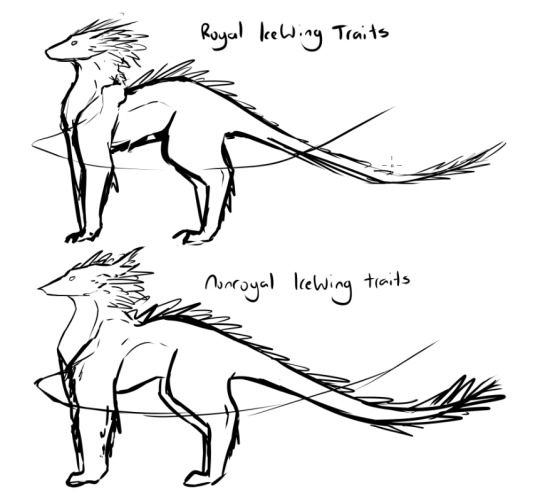
Life Cycle:
-IceWings are hatched in small clutches of one to three. Parents will carve out a nest in the ice, lay the eggs, and then allow them to freeze over again until the dragonets break through the ice. It is believed that the colder the eggs during incubation, the more powerful the dragonets will become.
-They take around 5 months to develop and are hatched strong enough to free themselves and big enough that most predators aren’t interested in them. They are also hatched with a delicate layer of spines all across their bodies that resemble frost crystals, though these later shed off. Dragonets can also go several days without eating after hatching, which is unusual for dragons.
-Most parents are available to watch their dragonets, so these abilities simply serve as precautions for the case of missing or neglectful parents.
-They grow somewhat slowly, reaching maturity a bit later than other tribes.
-IceWings, especially those of high rank, are expected to be strictly monogamous, and their marriages are usually more of a formality than a real union of affection. They aren’t incapable of love, certainly, but marriage is not treated as an act of love among nobles and royalty. Sometimes even lower-status IceWings marry out of societal expectation and not for their own happiness, but things are generally less strict.
Society + Culture:
-IceWing society is strictly ranked by class and birthright. There are seven divisions, referred to as Circles; the Seventh Circle is made up of dragons of low status, living in small villages on the outskirts of the tribe and scorned by those in higher Circles. The First Circle, meanwhile, is almost entirely comprised of royalty and other dragons of high honor and status. In the palace, dragons are expected to greet and interact with others differently depending on their relative ranking. The system is extremely strict and ruthless, and disrespect is one quick way to be lowered down the ladder. During her reign, Queen Snowfall tore down the wall used to keep track of the placement of each dragon, and made great steps toward lessening this aspect of their culture, but it continued to subtly persist long after her death.
-Lower-circle IceWing society is simple and straightforward. They live in communities quite detached from palace life, hunting for themselves and helping each other raise their dragonets. As all IceWing animus dragons were strategically kept in royalty, most animus gifts did little to improve the lives of those outside the First and Second Circles. The best way for a low-born IceWing to rise in rank would be through military work; otherwise, the groups remain fairly stagnant. Protests and revolts, though, are surprisingly uncommon. Most Sixth and Seventh Circle IceWings are simply too detached from royalty to be concerned with wealth differences, and royals likewise rarely bother to interfere with Sixth and Seventh circle dragons.
-While in the palace, during the worst of the class division, all dragons were commanded to wear necklaces made from a heavy metal that matched their rank. First-Circle necklaces would consist of one ring, Second-Circle necklaces would have two, one inside of the other, and so on. The more circles, the heavier the necklace, and Seventh-Circle dragons, on the rare occasion they visited the palace, would be forced into a constant bow by the weight of the metal.
-IceWings are quite superstitious, not unlike SkyWings. Their beliefs vary by region, but a generally common one is that the deep, impenetrable ice cap they live on harbors some ancient, powerful force, and that if it ever were to break or melt away, that power would be unleashed and cause havoc; they see the ice as a protective field that froze over at the dawn of time, and if it unfroze it would be the end of everything they know.
-IceWings will sometimes wear polar bear fur or the pelts of elk and deer, though not for warmth. Lower-Circle dragons will wear the pelts and sometimes even antlers of their own prey, for bragging rights. Higher-Circle dragons simply wear them as a fashion statement and a show of wealth.
-IceWings are educated much more about their own tribe than others, and generally prefer to stick to their own affairs. They have few exports to trade and little interest in those of others. They are not the most diplomatic tribe.
-After the perceived theft of their last animus, they not only blamed NightWings, but also harbored resentment for every other tribe with animus magic, believing themselves to be the original carrier of the gene and therefore the rightful possessor of it. They are extremely protective of even the least useful of their animus gifts.
Diet: Carnivorous. IceWings eat arctic mammals like elk and polar bears, and aquatic mammals like seals and even sometimes narwhals and orcas. They also eat fish and, rarely, a few species of birds. They have no way to cook food and no desire to. Other than a few types of berries in the mountains near the SkyWing border, no plants grow in the arctic, and IceWings live on meat alone.
354 notes
·
View notes
Text
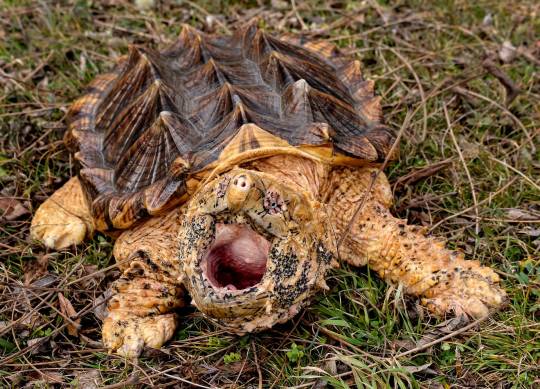

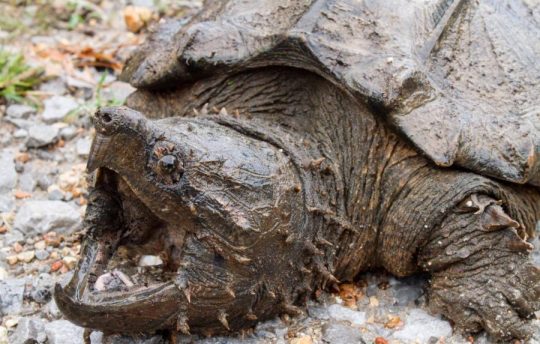
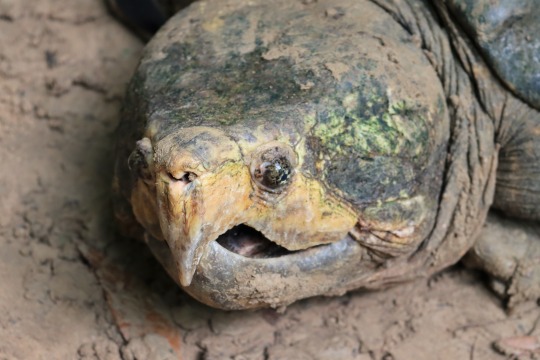
The Stupendous Alligator Snapping Turtle
Alligator snapping turtles (Macrochelys temminkii) are one of three recognised species of snapping turtle, all of which are found in North America. This particular species is found in the southeastern United States and the Mississippi Basin in particular. Macrochelys temminkii prefers deep freshwater, and is especially common in deep rivers, wetlands, and lakes.
The alligator snapping turtle is the largest freshwater turtle in North America, and is one of the heaviest in the world. Most individuals weigh between 70-80 kg (154-176 lbs), and are about 79-101 cm (31-39 in) long. However, the largest verified indiviual weighed over 113 kg (249 lb), and many others have been recorded in excess of 100 kg. The species is easily identifiable by its large, boxy head and thick shell with three rows of raised spikes. Typical alligator snapping urtles are solid black, brown, or olive green, though the shells of many older individuals can be covered in green algae.
M. temminkii is famous for its strong bite, which is most often utilised when feeding. The turtle's tongue resembles a worm, and at night individuals lie on the bottom of the river or lake bed with their mouths open. Fish are enticed by the bait-tongue, and when they get close enough the alligator snapping turtle's mouth clamps down around them. In addition to fish, this species may also feed on amphibians, invertebrates, small mammals, water birds, other turtles, and even juvenile alligators where their territories overlap. The alligator snapping turtle's relies on ambush techniques, and so hunters can remain submerged for up to 40 minutes. In some cases, individuals can also 'taste' the water to detect neaby mud and musk turtles. Because of this species' thick shell and ferocious bite, adults have few predators, but eggs and hatchlings may fall prey to raccoons, predatory fish, and large birds.
This species spends most of its time in the water, only emerging to nest or find a new home if their current habitat becomes unsuitable. Mating occurs between Februrary and May, starting later in the northern regions of the species' range. Males and females seek each other out, but generally don't travel great distances. About two months after mating, females dig a nest near a body of water and deposit between 10-50 eggs. Incubation takes up to 140 days, and the average temperature of the nest determines the sex of the hatchings; the hotter it is, the more males are produced. In the fall, hatchings emerge and are left to fend for themselves. Sexual maturity is reached at between 11 and 13 years of age, and individuals can live as old as 45 years in the wild.
Conservation status: The alligator snapping turtle is listed as Vulnerable by the IUCN. The species is threatened by overharvesting for meat and for the pet trade, and by habitat destruction.
If you like what I do, consider leaving a tip or buying me a ko-fi!
Photos
Ed Godfrey
Cindy Hayes
Eva Kwiatek
Nathan Patee
#alligator snapping turtle#Testudines#Chelydridae#snapping turtles#freshwater turtles#reptiles#freshwater fauna#freshwater reptiles#lakes#lake reptiles#wetlands#wetland reptiles#rivers#river reptiles#north america#southern north america#animal facts#biology#zoology
462 notes
·
View notes
Note
Interesting.. is it hot to the touch or cold?
What does the egg look like?
Uhm. Odd.
One half of it is like rainbow (plus some pink and brown).
And the other half is a weird ombré that’s white at the top and goes through a bunch of shades of gray till it reaches the black bottom.
#trying to figure out what kind of temperature we need to incubate the egg at#cause they all have different needs#depending on the kind of dragon
10 notes
·
View notes
Note
Hey, I have an intersex Salandit, who i originally thought was male as he was a rescue from a shiny breeding operation, but it turns out Ruth has enough "feminine" hormones that he could potentially evolve and I'm wondering if there's possible health problems that come from everstoning a salandit? Conversely, if an intersex salandit evolves are there health problems that come with that?
I've obviously scheduled a follow-up appointment with the vet to discuss this topic, and Ruth has his own particular health problems to consider, but I'm curious about the in-general answer? I am kind of interested in having a Salazzle, but I definitely care more about what's best for my special little guy.
oh, that's really cool!
salandit are a really interesting kind of pokemon because of their unique social and evolutionary structure. the sex of a salandit is an important determining factor for its role as either the leader or a member of a harem. salandit are also pokemon that heavily favor the production of male offspring, because a salazzle needs a sufficient number of males to help protect her eggs.
what's really neat about this, though, is that salandit's sex chromosomes are distributed in a way that should result in a 50/50 split in sex: XY males, XX females. the reason why there ends up being more males in the end is because salandit can actually change their anatomical sex while in the egg based on the temperatures they're incubated at. in very warm environments, with more resources, salandit with XX eggs remain anatomically female, but in colder environments where ensuring as many eggs survive as possible is more important, up to 35% of XX eggs will hatch anatomically male. they produce sperm and are able to fertilize eggs, though they can only supply X chromosomes.
im betting that's what's going on with ruth, especially since breeding mills aren't known to always provide ideal hatching parameters. the main concern if ruth evolved would pertain to his sex organs; while evidence of XX male salandit evolving is very rare, a specimen that was tracked and captured post-evolution ended up reversing sex again, i.e. turning into an anatomically and genetically female salandit.
we just don't know enough about this particular situation to know if there are any adverse affects caused by this kind of evolution. however, the good news is that, with proper management, most salandit dont need to evolve! they do very well with an everstone and rarely experience evolutionary stasis (it tends to only occur in female salandit kept with a large number of males). your vet will talk to you about watching for signs of any issues, but i think ruth will probably be okay as a funky little salandit.
125 notes
·
View notes
Text
mudwing headcanons

(PLEASE click on her she is so beautiful to me and tumblr kills her with hammers)
physical traits
another huge tribe; longer than ice wings, shorter, but very bulky and muscle-y (think alligator)
alligator is pretty much the keystone of my design for them, and also their design is probably the most canon compliant one i have (said moments before i go against this)
i do like the idea of giving them thicker tails, more adjacent to seawings than any other land dwelling tribe, and also just leaning into the swampy aspect of them more
depending on how aquatic of an environment they’re incubated in (and also depending on parent’s genetics) a mudwing can hatch with fins! it’s not entirely uncommon (fins smaller than seawing fins)
mudwings can have tail fins, fins running down their stomach, and their neck. this is distinct from seawings as mudwings never have fins running down their spine or fins on their limbs
mudwings have HUGE horns and ears to siphon heat away from their face
they also have a throat sac like icewings! they produce a variety of throat song, mostly akin to various frog sounds
also,,, tusks protruding from their lower jaw! (that i just realized i forgor to draw,,,,) this is used for foraging, and also agriculture (tilling soil, etc) which mudwings are particularly proficient in
mudwings also tend to have ecosystems growing from them,, algae and duckweed etc on their backs, necks, and tops of heads which helps camouflage them
speaking of camouflage,, colors,,,, well you know
mudwings only being brown is actually the most boring concept i've ever heard 😭so they’re not! brown is still the most common, green is also very common, muted reds, oranges, and yellows as accents float around as well
culture <3 (social structure)
okay i actually love the SCRAPS of culture content we have of the mudwings
so i guess i want to start out with family structure and community,,,
the whole “breeding night” is so fucking funny to me,,, and it’s staying. i will keep it. i think this can also coexist with courting and mating and committing to another dragon singularly, and maybe all mudwing communities just consist of really complicated polycules
although parents aren’t always directly and singularly involved in the raising of their clutches, the adults still communally raise/look after the hatchlings, even if it’s somewhat from a distance
also, i think clutches know their parents and vice versa, even if there’s no special connection, you have to avoid incest somehow,,,,
so sib groups grow up together and rely on one another, like how it is in canon
if a bigwings egg is a “dud” and doesn’t hatch or is,,, abducted from the nest for the purpose of a false prophecy,,,, it’s actually really detrimental to the other eggs and can put them at risk to not hatch
clay’s sibs successfully hatching and growing up is,, a miracle im saying. the bigwings is the CRUX of everything. first to hatch, fastest to develop, grows the biggest, etc etc
i also think bigwings can produce fire at a slightly wider range of temperatures in order to keep their sibs warm if they’re ever under duress
on the topic of clutches and bigwings and,, everything
one egg clutches are considered crazy bad luck, and they need a lot of maintenance from an older dragon in order to actually hatch
if it’s feasible (like a clutch of a bigger size was laid on the same day) the single egg will be transplanted into that bigger clutch asap
also a similar feeling about 2 egg clutches, but it's not as bad
single and 2 egg clutches happen VERY frequently with hybrids, so often a hybrid will be in another sib group and all of their sibs go “yes they are us. oh they’re purple? they’re literally us what do you mean”
on the topic of hybrids, seawing and mudwing hybrids are insanely common, to the point where the majority of mudwings on that border are at least a liiiiitle bit seawing
there’s a lot of communal learning and passing down traditions in agriculture, farming, and animal rearing, and oftentimes a family farm is passed down from one sib group to another
(i don’t only make humble farmer mudwings though, there’s also a lot of artisans, scholars, the equivalent of dragon environmentalists, etc)
so moving away from family groups and stuff,,,,, onto wider society, let’s start with the royal family
mudwings pass the crown down from eldest daughter to eldest daughter, through a “royal” line
basically, one group of sibs has the crown, then the oldest/first clutch will be promised the crown, but it can very easily be abdicated and passed to a different clutch if the oldest clutch doesn’t want it or seems not fit to rule
there’s not a lot of competition for the crown because sib groups rule together, and the queen position really doesn’t mean anything, at most acting as a tiebreaker
obviously, sibs never fight sibs for the crown. that’s like speed running a revolution from the mudwing commoner population. but also, cousins don’t tend to fight either because of this strong wider communal feeling
fashion, jewelry,,
i think mudwings don’t have a lot of fashion/accessories because of how swampy and wet their environment is. royals will have jewels embedded into their scales (like moorhen) but even this requires somewhat regular cleaning to actually look,, pretty and shiny? so it’s not common
other jewelry consists of tight bands of wood and clay around horns, clay earrings, rings and armbands
clay jewelry is especially common! including clay beads that represents their sibs
clay fired earrings, strings of clay beads draped across the body, etc is commonly found
jobs! (and also a rant on cuisine apparently)
briefly touched on earlier, idk how much expanding i’ll do here tbh
farming is pretty common, crops including rice, cranberries, watercress, taro, water spinach, water chestnuts,,,, you get the point. there’s a lot of crops to be grown and mudwings grow them!
not in monocultures though, there’s a lot of mixing of crops on the same farmland
also with farmers, animals are raised! but closer to the less swampy edges of the kingdom
they’re still partially wild honestly, but mudwings rear cows and boars very commonly
so much of mudwing economy revolves around food, so they have a very robust cuisine, and they grow/trade for a lot of spices and herbs (with the skywings) and they have a lot of practices surrounding food/sharing of food being sacred
oh god.,,,, the tangent is taking over,, im so sorry
marriage!! i think when mudwings want to get married there’s a long string of cooking for one another!! back and forth making beautiful dishes for one another until they make a beautiful dish TOGETHER. god i love them
aside from farmers, a lot of mudwings are artists! they carve wood and make clay sculptures and jewelry as well as weave baskets and jewelry and thatched roofs from fronds and other wide-leafed plants
pottery is also common
tanners make leather from cow and boar hide, and bookbinders make books (after contact with pantala) and trade with sandwings for dried parchment
also butchers, cheesemakers (cows milk)
as well, the typical circle of scholars and nobles that keep rigorous records on the queendom’s history
and of course, royal diplomats
religions/superstitions
less superstitious than icewings perhaps,, but i do think they have some shared beliefs
perhaps just in a “mother earth” “all mother” type of concept? a dragon that gave them swamps, and then all other life came from swamps, etc
of course, the egg superstitions from earlier
there’s a lot of superstitions/outright magic about sharing food and the etiquette around sharing food
oh, one of you dropped your utensil while eating? in the future you’re going to save each other from mortal danger
someone gifting dishware is considered a proposal,, but it can be platonic or romantic
the monarch spilled their drink? the rainy season will be rainier this year
just a lot of really niche things
yoppee, i love mudwings so much. i think there is so much untapped potential and what we have now is beautiful. love drawing them, love their color palettes, love their sib groups. yeah not much else to say here. as always, send a dm or an ask if you want to know about something further!
#wof#wof mudwing#wof art#wof worldbuilding#wof redesign#wof rewrite#wings of fire#wingsoffire#wings of fire fanart#wof fanart
120 notes
·
View notes
Note
So I know overall yandere talk is on Skully atm, but I've been having some thoughts kicking around in my head for the Heartslabyul hive and how it could work. So here are some of my thoughts for it:
Why is the hive so desperate for a Queen? (Breeding Queen?)
My current thought is that maybe Riddle's mother was the last Queen. And for whatever reason, the hive rejected her. This can happen with bees if their queen gets a parasite or the like, but the overall process beyond that would be to already be breeding another, but just starve the last Queen to death. Or brutal regicide, kind of depends.
I mean, it's Riddle's mom, whatever reason can kinda fit. But for some reason, the hive was still unable to produce their own queen naturally. So they went out and procured the next best thing.
Even better if Riddle was *supposed* to be the next Queen that was being raised, but ended up being a drone. This screws up the last Queen's plans, making he far more brutal or violent or whatever.
And maybe he and the other drones (the Hearts boys) didn't like the mistreatment from her. Sooooooo Regicide? And that is when they get desperate looking for a new Queen.
2. Why go for a human?
Could be convenience, could be temperature is just right. Either way, if the way the drones work is that they're depositing eggs into their darling, then fertilizing them, then that would just be using their own egg and sperm. This could explain the breeding rotations, though.
One dude fills with eggs, the next fertilizes them. Keeping some genetics in there and providing some diversity. Unless Riddle can, somehow, be the only one who can deposit eggs and the rest can fertilize? But I kind of like the idea of them taking turns for clutches and for quicker rounds.
I would imagine whoever is on the clutch rotation, though, would be pampered just as well as their precious incubator. Maybe they spend a lot of time together, getting fed good foods, courting a bit. Making eggs in general is, of course, very energy/time consuming for the body. So the idea of the egg-depositor getting to be spoiled
Maybe most of the drones let this be Riddle most of the time after all the BS with his mom. Maybe they just like spoiling the two of them the most, but they get turns sometimes too. Sometimes Riddle wants to spoil others, obviously~
3. Pheromones
Hot. Little bit of hypnotism, little bit of bug stuff. Very good recipe for breeding shenanigans.
4. Hierarchy
I like the idea that the Queen is at the top, but second to her is the "King." The way this could work is that the Queen is the one who (normally) produces eggs for the hive, then everyone else in the hive tends to her. Y'know, bee logic. Drones are constantly breeding the Queen in order for her to produce said eggs, then all the workers are feeding her and cleaning her, etc.
But I like the idea for this hive is that it works like this:
Socially speaking, the Queen is at the top. The Queen births the young. Then, there's a King, the one who's decided is like. The best genetics or something along those lines. Maybe the brightest colors (Riddle with his bright red hair and the like) determines who has the strongest genetics.
Then the other drones are beneath him. The King's main duties are tending to the Queen and ensuring she is best cared for.
---
Anyway, I have more thoughts but these are the ones to kick around for now.
--Science Freak Anon 🤡🧪
👁 👁 my dear science freak anon, this is so DELICIOUS!!!! I am devouring each of these thoughts like a starved dog who has just discovered a veritable FEAST. The idea of breeding rotations is especially scrumptious........ if the responsibility fell to Riddle to keep the hive in line while searching for a new queen, it's only right to do so through rules and schedules. The same goes for breeding so that no one is too greedy with you, and everyone is granted a turn so long as they follow the schedule. OTL
AAAAAA I love the idea of mutual pampering, too!!! >w< both of you being spoiled after so much physical exertion. orz the entire hive doing what they can to make things comfortable, adoring you so much!!!
#twisted chit chat#science freak anon 🤡🧪#n/sfw#tw: breeding#these thoughts are so good AAAAA#going to be thinking about them a lot...
95 notes
·
View notes
Note
do any snakes care for their young, even at least as eggs? is separating eggs from the parent always mandatory in captivity?
So, disclaimer first: the vast, vast majority of snakes just lay eggs or have the babies and then get out of there immediately. Snakes, as a rule, are not the type of animals to care for their young at all.
But there are some exceptions!
Vipers as a family are the most well-known for it; some rattlesnakes especially are known for staying to guard their babies until their first shed (which happens within a week of their birth).

Most pythons, too, will choose to remain with their eggs throughout the entire incubation period, coiling around them to protect them and keep them warm. Some pythons even have such strong brood instincts that they'll choose to coil around eggs that aren't even theirs! It's a true rarity in the snake world.

King cobras are probably the coolest. They'll build a big nest for their eggs by coiling themselves around leaves and sticks and guard it until just before the babies hatch. King cobras eat snakes, so their instincts tell them to leave before it's time for the babies to start hatching.

In captivity, many breeders choose to remove eggs for a few main reasons. The first is that it's easier to keep tabs on the eggs' incubation, remove any infertile eggs (especially to keep mold or disease from spreading), and closely control the temperature and humidity levels for the eggs. The next reason is that pythons will not budge from those eggs, and since many snakes go off food before laying eggs and it would mean another two months without food, many keepers remove eggs to encourage the snake to eat again so they don't lose too much weight. Some breeders do choose to leave eggs with a python, though - it's up to personal preference, really.
304 notes
·
View notes
Text
today's gay animal of the day is...

bearded dragons!
among some reptile species, the temperature surrounding the egg as it incubates can dictate whether it hatches as a female or male. sometimes, in bearded dragons, temperature changes will result in one that has the body of a female, but the behavior of a male, including mating with other females!
61 notes
·
View notes